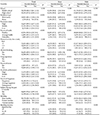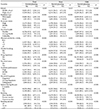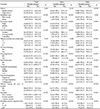The Relationship between Smoking and Suicidal Behavior in Korean Adolescents: 12th Korea Youth Risk Behavior Web-based Survey
-
Hye Won Kim, Yang Keun Kim, Jae Yong Paik, Chang Bin Hong, Kayoung Lee, Tae-Jin Park, Jinseung Kim

- Received July 03, 2017 Accepted October 17, 2017
- ABSTRACT
-
- Background
- Suicide is the first leading cause of death among teenagers in Korea, and smoking is reported to be one of the risk factors for suicide. The purpose of this study is to investigate the relationship between smoking and smoking amount and suicidal behavior using data from the Korea Youth Risk Behavior Web-based Survey (KYRBS).
- Methods
- Using the 12th KYRBS 2016, we surveyed smoking, smoking amount, suicidal ideation, suicidal planning, and suicidal attempt of adolescents. And a total of 65,528 respondents were divided into current smoker, former smokers, and non-smoker, and 4,012 smokers were classified into ≤9 cigarettes/day group, 10–19 cigarettes/day group, and ≥20 cigarettes/day group according to the amount of smokers. We analyzed the relationship between smoking and smoking amount and suicidal ideation, suicidal planning, and suicidal attempt using multivariate logistic regression analysis.
- Results
- As a result of adjusting for all confounding variables, the current smoker has an odds ratio of 1.143 (confidence interval 1.020–1.281) with suicidal ideation compared to non-smoker and the odds ratio of suicidal planning and suicidal attempt is also statistically significant, respectively. And the odds ratio of all suicidal behaviors was significantly higher in ≥20 cigarettes/day group than in ≤9 cigarettes/day group, respectively.
- Conclusions
- We found that smoking and smoking amount was related to suicidal ideation, suicidal planning, and suicidal attempts in adolescents. Therefore, suicidal prevention strategies considering this relationship should be established.
- REFERENCES
- REFERENCES
- 1. Korea National Statistical Office. 2015 Annual report on the cause of death statistics [Internet]. Daejeon: Korea National Statistical Office; 2016;Accessed Jun 28, 2017]. Available from: http://kostat.go.kr/portal/korea/kor_nw/2/6/2/index.board2. Sohn SY. Factors affecting suicidal ideation, suicidal plan and suicidal attempt in Korean adolescents. J Korea Acad Ind Coop Soc 2014;15(3):1606-1614.
[Article]3. Kim HS, Kim BS. A comparative study on suicidal ideation in the elderly and the adolescents. J Korean Gerontol Soc 2008;28(2):325-343.4. Jeon HS. Effects of smoking, drinking, and drug use on the adolescent's suicidal ideation by using the data of the Korea youth risk behavior web-based survey through from 2008 to 2014. J Korean Soc Sch Health 2015;28(2):99-110.
[Article]5. Ladame F, Jeanneret O. Suicide in adolescence: some comments on epidemiology and prevention. J Adolesc 1982;5(4):355-366.
[Article] [PubMed]6. Hagh YH. A study on actural condition of junior high school students' suicidal ideation [dissertation]. Seoul: Ewha Womans University; 2001. Korean.7. Harris EC, Barraclough B. Suicide as an outcome for mental disorders. A meta-analysis. Br J Psychiatry 1997;170(3):205-228.
[Article] [PubMed]8. Park H. Effect of sleep duration on suicidal ideation in Korean adolescents. J Korean Soc Sch Health 2015;28(1):1-9.
[Article]9. Runeson BS, Beskow J, Waern M. The suicidal process in suicides among young people. Acta Psychiatr Scand 1996;93(1):35-42.
[Article] [PubMed]10. Bettes BA, Walker E. Symptoms associated with suicidal behavior in childhood and adolescence. J Abnorm Child Psychol 1986;14(4):591-604.
[Article] [PubMed]11. Kim HS, Kim BS. Verification of the structural relationship model of suicidal ideation to its related variables. Korean J Couns Psychother 2008;20(2):201-219.12. Kim BY, Lee CS. A meta-analysis of variables related to suicidal ideation in adolescents. J Korean Acad Nurs 2009;39(5):651-661.
[Article] [PubMed]13. Wo C, Kim P. The multidimensional structure analysis of variables related to adolescents' suicidal ideation. Korean J Youth Stud 2011;18(4):219-240.14. Chin YR, Lee HY, So ES. Suicidal ideation and associated factors by sex in Korean adults: a population-based cross-sectional survey. Int J Public Health 2011;56(4):429-439.
[Article] [PubMed]15. Taylor A, Dal Grande E, Gill T, Fisher L, Goldney R. Detecting determinants of suicidal ideation: South Australian surveillance system results. Int J Public Health 2007;52(3):142-152.
[Article] [PubMed]16. Hemmingsson T, Kriebel D. Smoking at age 18–20 and suicide during 26 years of follow-up-how can the association be explained. Int J Epidemiol 2003;32(6):1000-1004.
[Article] [PubMed]17. DeBry SC, Tiffany ST. Tobacco-induced neurotoxicity of adolescent cognitive development (TINACD): a proposed model for the development of impulsivity in nicotine dependence. Nicotine Tob Res 2008;10(1):11-25.
[Article] [PubMed]18. Scherrer JF, Grant JD, Agrawal A, Madden PA, Fu Q, Jacob T, et al. Suicidal behavior, smoking, and familial vulnerability. Nicotine Tob Res 2011;14(4):415-424.
[Article] [PubMed] [PMC]19. Kessler RC, Berglund PA, Borges G, Castilla-Puentes RC, Glantz MD, Jaeger SA, et al. Smoking and suicidal behaviors in the National Comorbidity Survey: replication. J Nerv Ment Dis 2007;195(5):369-377.
[Article] [PubMed] [PMC]20. Hemenway D, Solnick SJ, Colditz GA. Smoking and suicide among nurses. Am J Public Health 1993;83(2):249-251.
[Article] [PubMed] [PMC]21. Ministry of Education, Ministry of Health & Welfare, Korea Centers for Disease Control and Prevention. The 12th Korea youth risk behavior web-based survey 2016 [Internet]. Sejong: Ministry of Education, Ministry of Health & Welfare, Korea Centers for Disease Control and Prevention; 2016;Accessed Nov 7, 2016]. Available from: https://yhs.cdc.go.kr/new/pages/pds1.asp22. Chen M, Wang EK, Jeng YJ. Adequate sleep among adolescents is positively associated with health status and health-related behaviors. BMC Public Health 2006;6:59.
[Article] [PubMed] [PMC]23. Cho SJ, Jeon HJ, Kim JK, Suh TW, Kim SU, Hahm BJ, et al. Prevalence of suicide behaviors (suicidal ideation and suicide attempt) and risk factors of suicide attempts in junior and high school adolescents. J Korean Neuropsychiatr Assoc 2002;41(6):1142-1155.24. Woo CY, Park AC, Jeong HH. The structural relationship among human relations, stress, depression and suicidal ideation of adolescents by genders and level of school. Korean J Educ Psychol 2010;24(24):19-38.25. Park E. The influencing factors on suicide attempt among adolescents in South Korea. J Korean Acad Nurs 2008;38(3):465-473.
[Article]26. Kwak SJ, Yi YJ, Jung HS. The analysis on factors related to suicide ideation of middle and high school students in Korea. J Korean Soc Sch Health 2009;22(2):103-111.27. Oh SM, Sohn JH, Chang SM, Seong SJ, Lee JY, Bae A, et al. Correlation between tobacco smoking and mental disorders including suicidal tendencies. J Korean Neuropsychiatr Assoc 2011;50(5):375-385.
Table 1

Values are presented as number (%) using frequency analysis in complex sample design.
aP values are obtained by F-test.
bPhysical activity for a week is defined as a day in which a total of 60 minutes or more of a day ‘physical activity of the heartbeat is increased or breathed’ during the past 7 days.
Table 5

Values are presented as adjusted odds ratio (95% confidence interval). Calculated by multivariate logistic regression analysis using complex sampling design.
aLogistic regression for suicidal ideation with smoking and smoking amount without adjustment.
bLogistic regression for suicidal ideation with smoking and smoking amount after adjustment for school, residence type, and economic status.
cLogistic regression for suicidal ideation with smoking and smoking amount after adjustment for school, residence type, economic status, perceived health, physical activity for a week, alcohol drinking, and drug experience.
dLogistic regression for suicidal ideation with smoking and smoking amount after adjustment for school, residence type, economic status, perceived health, physical activity for a week, alcohol drinking, drug experience, perceived stress, academic performance, perceived happiness, and sadness during the past 12 months.
eP values are obtained by F-test.
Table 6

Values are presented as adjusted odds ratio (95% confidence interval). Calculated by multivariate logistic regression analysis using complex sampling design.
aLogistic regression for suicidal planning with smoking and smoking amount without adjustment.
bLogistic regression for suicidal planning with smoking and smoking amount after adjustment for school, residence type, and economic status.
cLogistic regression for suicidal planning with smoking and smoking amount after adjustment for school, residence type, economic status, perceived health, physical activity for a week, alcohol drinking, and drug experience.
dLogistic regression for suicidal planning with smoking and smoking amount after adjustment for school, residence type, economic status, perceived health, physical activity for a week, alcohol drinking, drug experience, perceived stress, academic performance, perceived happiness, and sadness during the past 12 months.
eP values are obtained by F-test.
Table 7

Values are presented as adjusted odds ratio (95% confidence interval). Calculated by multivariate logistic regression analysis using complex sampling design.
aLogistic regression for suicidal attempt with smoking and smoking amount without adjustment.
bLogistic regression for suicidal attempt with smoking and smoking amount after adjustment for school, residence type, and economic status.
cLogistic regression for suicidal attempt with smoking and smoking amount after adjustment for school, residence type, economic status, perceived health, physical activity for a week, alcohol drinking, and drug experience.
dLogistic regression for suicidal attempt with smoking and smoking amount after adjustment for school, residence type, economic status, perceived health, physical activity for a week, alcohol drinking, drug experience, perceived stress, academic performance, perceived happiness, and sadness during the past 12 months.
eP values are obtained by F-test.







